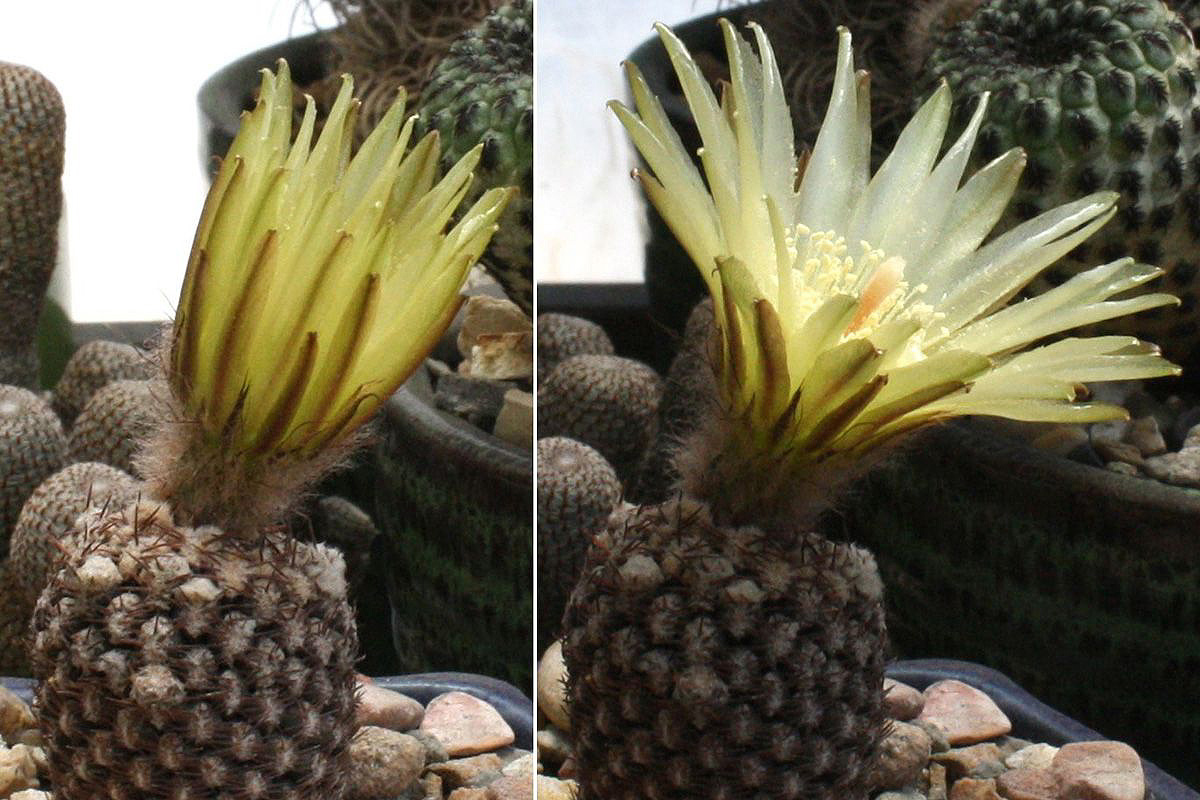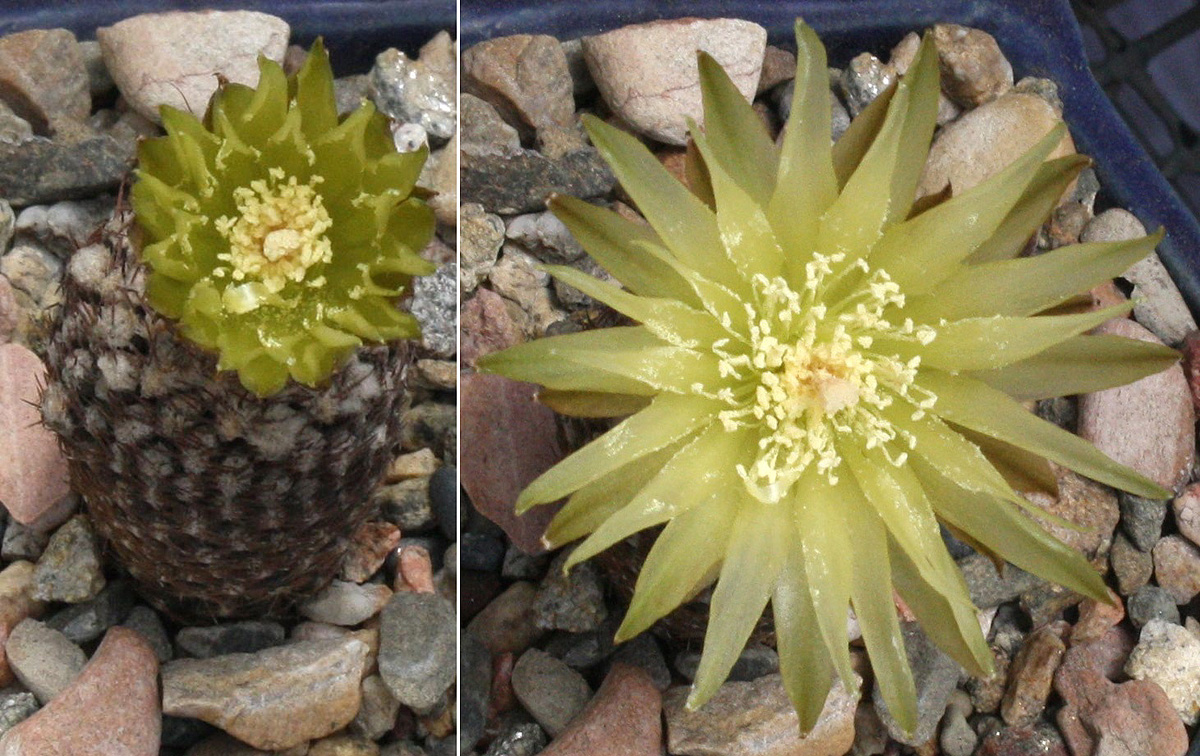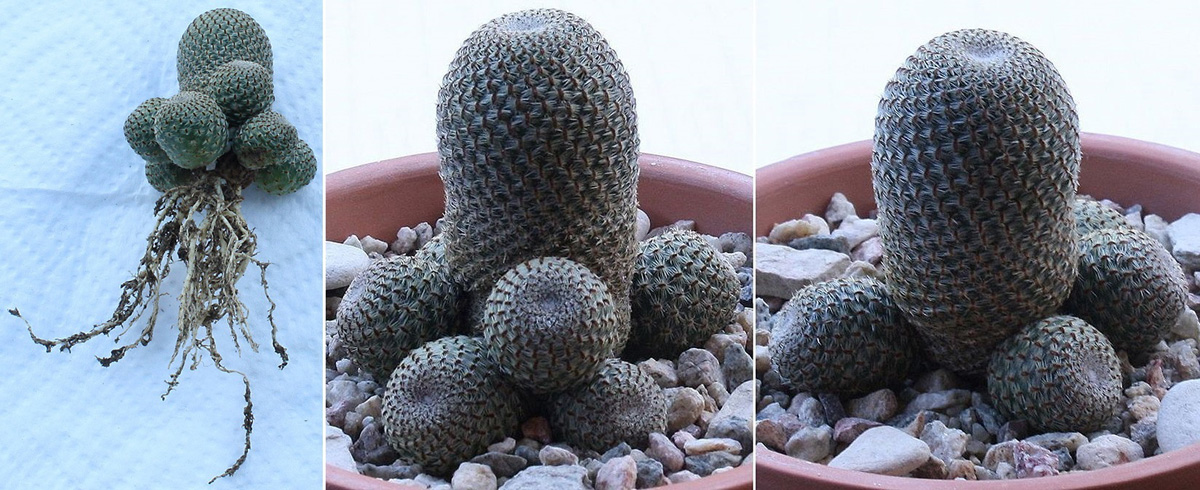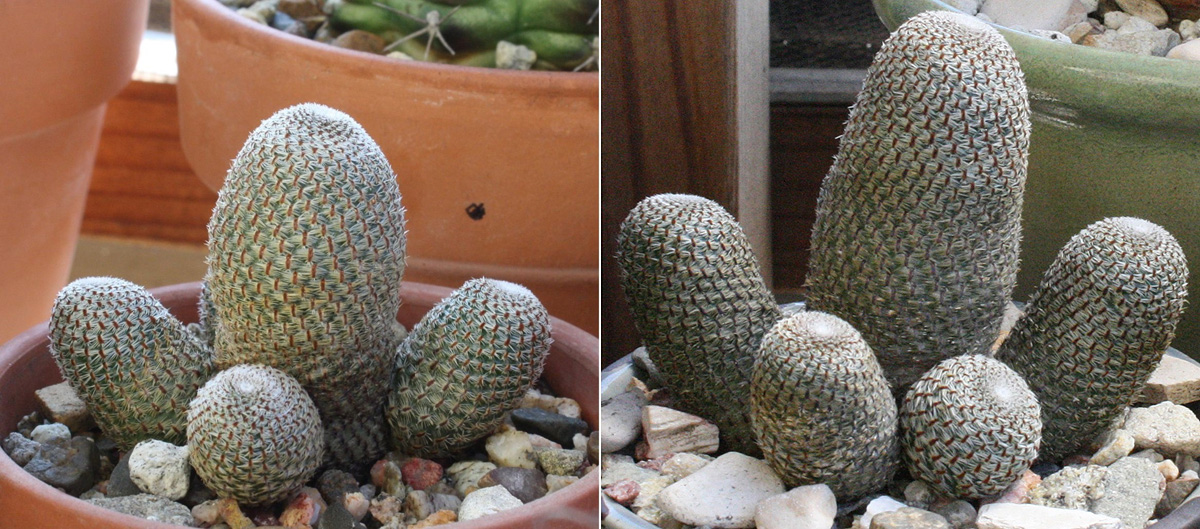And who wouldn't like a cactus called "dead man's fingers"?
Puna clavarioides
An example from Cactuspedia:

It's the most wonderfully odd Opuntioid you'll ever see. The plant in this photo is pretty old, so if I could even find a P. clavarioides, I knew it'd have to be a young 'un. The finding was difficult, but when I put the call out to my usual sources, Craig Fry of C and D Plants finally answered. Here it is on 12/18/15:


Yep, that
is a young 'un, so my first challenge was to find a pot that would be small enough for it. A diameter of 2 inches should be about right, although my 2" glazed ceramic pots were being occupied by other cacti. Luckily I'm a pack rat when it comes to pots, and I had a 2" x 2" terracotta pot that would do for the moment. Craig warned me that clavarioides cuttings aren't the easiest to root, and once they do, they take a long time to establish. Such being the case, my second challenge was to determine the mix I should use. Soil-less mix? My experience with the Tephros made me think twice about that. However, their 50/50 mix might be too much soil for the tiny guy, so I split the difference and decided on pumice and granite gravel with 30% soil added in.
When spring 2016 kicked in, I wanted to see if there were any signs of activity below-ground. Doing a check on 4/24/16, I was pleased to see a tiny new root stub:

Could this be the beginning of new roots about to grow? Let's find out -- the view on 5/14, 7/10, and 9/17/16:

There's only one way the clavarioides is plumping like that -- new roots! Then I accidentally unpotted the plant. Wasn't happy about seeing them torn off in the process, but at least it exposed 2 brand new root stubs (9/24/16):

I can only go by Craig's experience with the species, so if he was right, this is a setback. Or is it? A
very pleasant surprise revealed itself in early April 2017, so let's have a look on 4/9, 4/20, and 5/29/17:

Take the "after", turn it into a "before", and we'll see another pleasant surprise to end the summer of 2017 (10/8):

With the progress I saw, I was confident about moving the plant into a somewhat bigger glazed ceramic pot. The deed done on 6/17/18:

The roots are sparser than I expected, and while I don't have much to go on, it's possible that cuttings may not have much of a root system compared to clavarioides being grown from seed. FYI, Tephrocactus have taproots only if they're seed-grown, and the same applies to Puna. Since my Tephros are cuttings and their roots aren't all that extensive either, my guess is it'll be normal to have the clavarioides growing rather sparse roots. Interesting to think about, but as a more practical matter, I was concerned about whether or not those roots would have to establish all over again after the repot. The 2018 results on 6/17 and 10/7:

Looking good, although I do have to wonder if the plant will be in the mood to grow anything new above-ground this year. Nothing so far, but we still have plenty of growing season left. If the clavarioides produces new activity worth reporting, I'll post an update in my 2019 end-of-summer review.
Craig was very kind about including a bonus gift with the Puna, and it is...
Cumulopuntia rossiana var. fuauxiana
Quoting from CactiGuide, the genus is "only found through specialist nurseries or traded between growers. This is not unlike other Opuntioids which are often hated or loved by cactus growers, with the former being more often the case." The Frys (hello, Denise!) and I are among the minority, so they must've instinctively known that I would enjoy having this gem:

The tiny plant needed a tiny pot, so I rustled up another 2" terracotta pot for the job:

Don't know why, but I had a feeling that the plant would A. have no trouble rooting, and B. do well in pure mineral mix. Was I correct? The results on 12/18/15, 9/24/16, 10/8/17, and 10/20/18:


Nailed it. The rossiana is ready for a bigger pot, and this time it'll be glazed ceramic. When I repot it soon, we'll get to see what the roots look like these days. I'm a sucker for miniatures anyway, and Craig chose well -- it's a gift that keeps on giving!
That wraps up my Opuntioid group, so we'll move on to the...
Fraileas
2 species are represented on my plant bench, and the first one has a C and D connection. (There's a nice story behind it, so if you haven't seen it before, you can check it out
here.) First photo on 3/15/14, and the green arrow points us to the cactus we'll be reviewing:

Although I've purchased most of my cacti online, there's an advantage to buying them at a brick-and-mortar because you can see exactly what you get. And growing conditions are likely to change when plants go from someone else's place to yours, so in this case it was another advantage to actually see C and D's growing conditions, then observe the changes that took place after the cactus came home with me.
Repotting day on 3/18/14 -- do you know what it is?
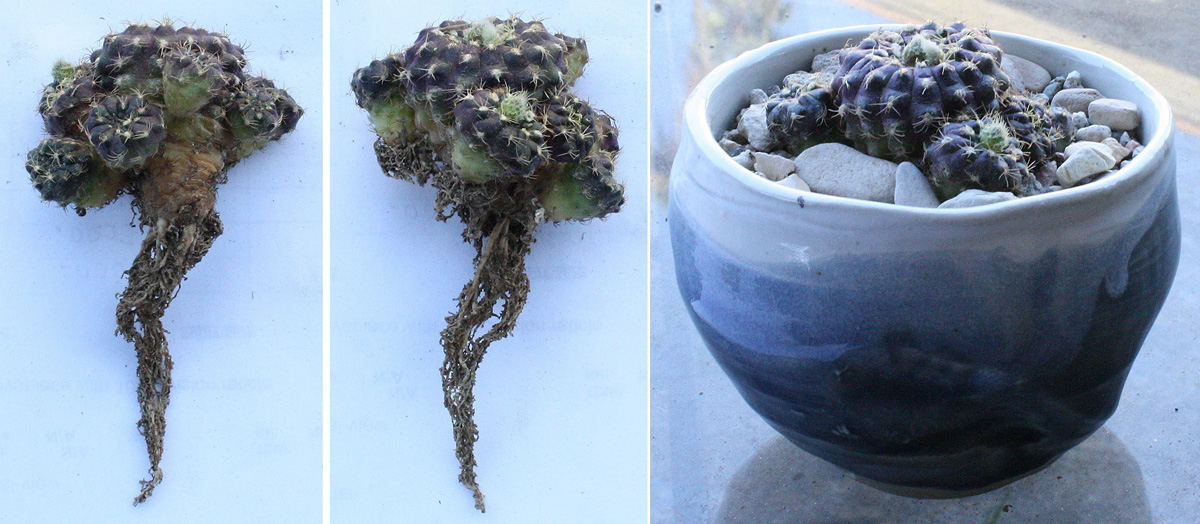

If you don't, that's Frailea grahliana. Craig's mix for cacti is nice and lean, but there's nothing leaner than pure mineral mix. Okay, that's one change. Fraileas are sun-lovers, so the grahliana gets plenty of sun time -- that's another change going from the lighting in his greenhouse to the top shelf of my plant bench. The difference is significant -- the plant looked pretty angry about it on 4/17/14, but we have a happy suntanned grahliana 5 months later:

A side shot going from summer to summer on 9/20/14 and 9/19/15:

The grahliana was ready for a bigger pot, and the funky one you just saw is now occupied by my Copiapoa laui. Repotting day on 4/24/16:

Those roots look great, and the plant apparently wasn't bothered by growing in "dirty" mineral mix. Then again, clean is always better than dirty. The species offsets freely, and using clean mineral mix to work with, my grahliana could eventually fill its new pot with more pups. Let's find out if things are starting to go in that direction -- 9/17/16 and 10/9/17:

Hmmmm, not what I was hoping for. I remember reading that Fraileas are thirsty plants, so when I had the grahliana in its smaller pot, I was watering it every 2 weeks in the spring and once a week during summertime. When I moved it into a bigger pot, I thought it would be fine with watering every 2 weeks in spring
and summer. If that was a boo-boo, it was easy enough to correct, so I went back to watering the plant once a week last summer. We'll take the "after", turn it into a "before", and here are the results on 10/6/18:

There we go, from thirsty and stressed to being beautiful again. With another summer just around the corner, I'll make sure it stays that way. Fraileas have a short lifespan, lasting only 10-15 years. When the parent stem dies, all those grahliana pups will be there to soldier on.
My interest in Fraileas began when I fell in love with an F. castanea I saw many years ago. (Can't remember where it was, but might've been the
Huntington's desert collection.) I'm used to the fact that my tastes run toward hard-to-find species, and castanea is certainly one of them. I had it on my wish list when I went to the California Cactus Center in 2011, but they didn't stock Fraileas of any kind. My only other source in 2012 was CoronaCactus Nursery, and when I contacted Darryl Craig to inquire about the Echinocereus rubsipinus featured in Part 6, he offered to sell me a 2-year-old castanea seedling. Sold! Such a pretty little thing it was, and the plant did well until it died in the fall of 2016. Of course I didn't know what a dead castanea looks like, but now we do -- 2/25 and 4/20/17:

I was all prepared for a nice shriveling-plumping "before and after" pic, but no amount of water was going to bring the poor thing back. CoronaCactus didn't have any in stock, although Miles' To Go did at one time, so I emailed Miles Anderson and asked him if he happened to have a castanea available for sale. Indeed he did, and here it is on 7/8/17:

Looking back on it now, I realize that "dirty" mineral mix shortened the first castanea's life. I wasn't about to repeat that mistake, so it's nothing but clean mix with this one. On 3/27 and 4/21/18, here's the shriveling-plumping photo we'd like to see:

The view on 7/8/17 and 10/7/18:

Pure mineral mix and plenty of sun gives us a nice flat, chestnut-brown castanea, and the plant's growth is way better than my first one ever was. The bud you see in the 7/8/17 pics did go into flower, and that's because it started growing in the high heat of Arizona. The species needs a lot of heat to go from buds to blooms, so the only downside to my temperate climate is to have castanea go straight from buds to seed pods. And boy, does it produce! Kinda fun to watch too -- a pod about to pop (6/25/18):

Then 5 days later, it dehisced, leaving behind another bud:

Fraileas are remarkably self-fertile, so with the castanea, I'll just let it dehisc its seeds all over the pot. The idea is that if enough seeds get down in there (and I should probably help), sooner or later some of them will sprout. If this works, seedlings growing in the pot would be good "insurance" plants to cover the parent plant's death. Although you Frailea lovers out there may disagree, IMO castanea is the best of the genus.
By the way -- I track the number of new page views I get whenever I post, and the numbers I've seen recently are quite amazing. I can't thank all of you enough for being interested in the work I'm doing here on the forum!




































































